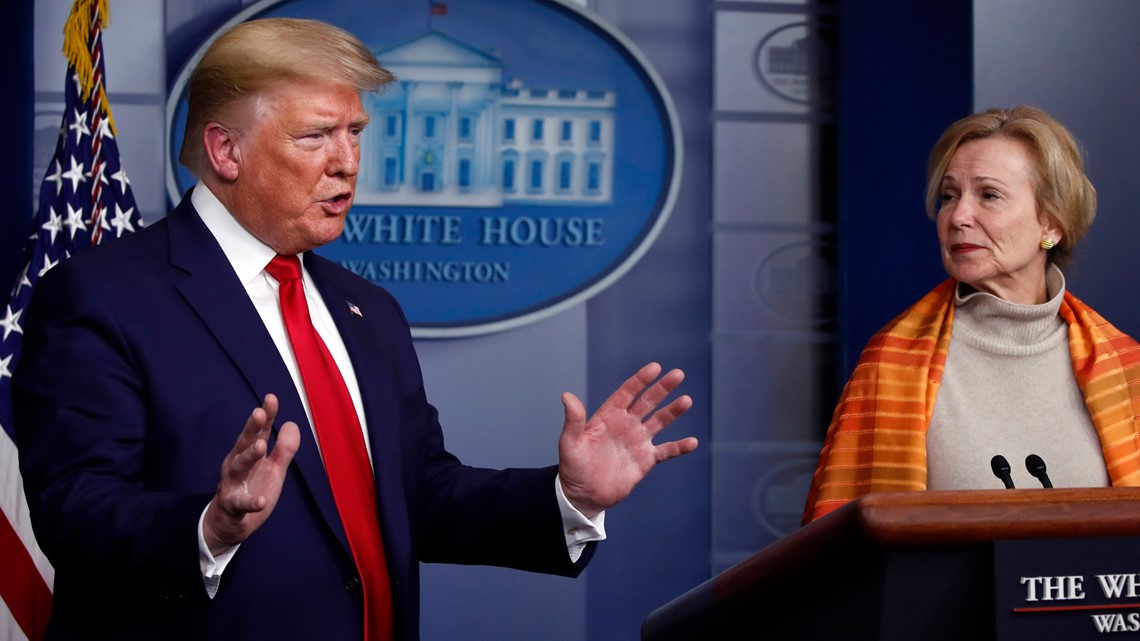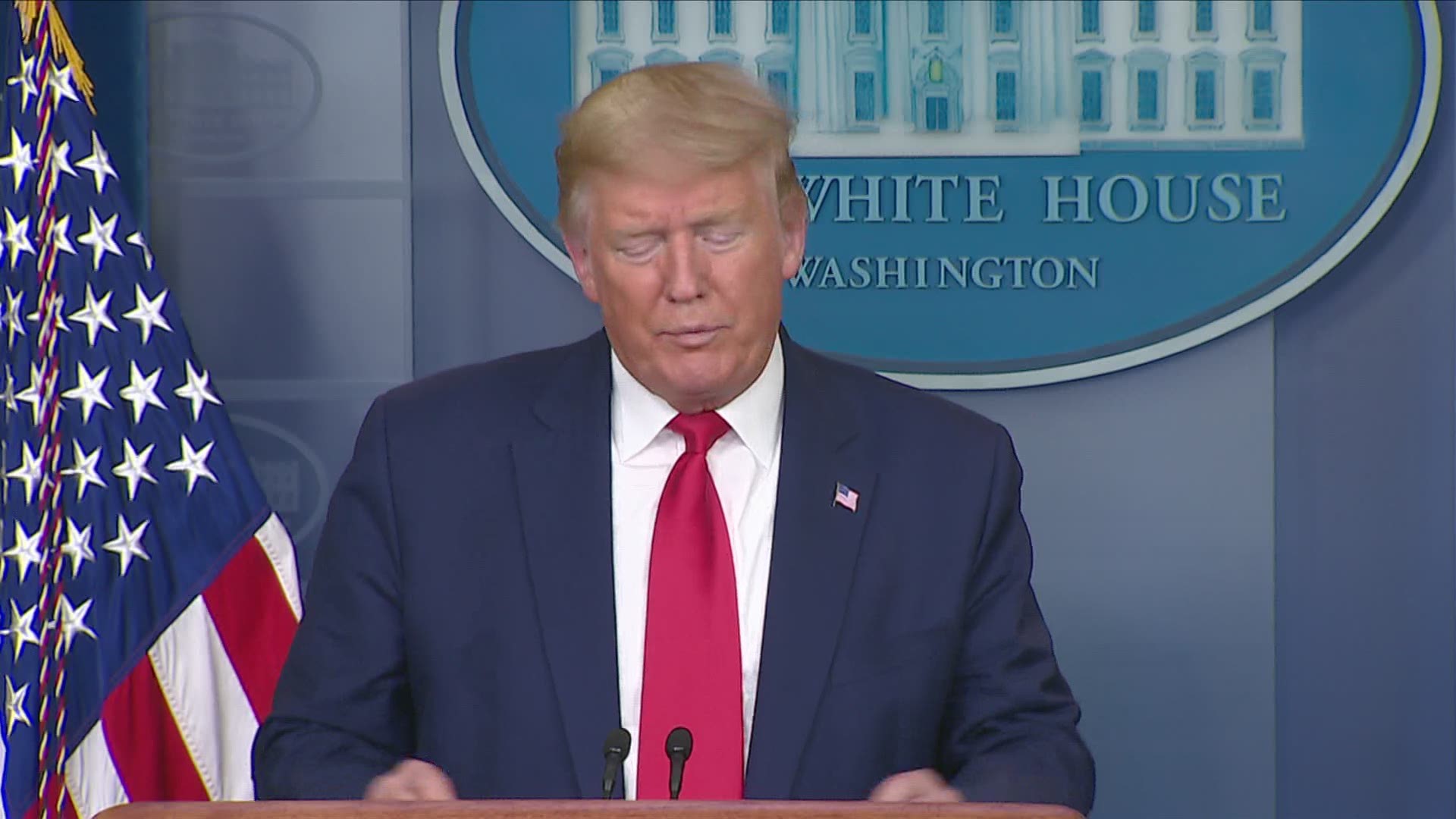WASHINGTON — President Donald Trump announced new federal guidelines Friday recommending that Americans wear face coverings when in public to help fight the spread of the new coronavirus. The president immediately said he had no intention of following that advice himself, saying, “I'm choosing not to do it."
The new guidance from the Centers for Disease Control and Prevention encourages people, especially in areas hit hard by the spread of the coronavirus, to use rudimentary coverings like T-shirts, bandannas and non-medical masks to cover their faces while outdoors.
The president exempted himself from his administration's own guidelines, saying he could not envision himself covering his face while sitting in the Oval Office greeting world leaders.
“It's a recommendation, they recommend it," Trump said. “I just don't want to wear one myself.”
The new guidance, announced as states are bracing for critical shortfalls like those that other parts of the world have experienced, raises concern that it could cause a sudden run on masks.
RELATED: Coronavirus live updates: US has over 7,000 deaths; Americans recommended to cover faces in public
Trump and other administration officials sought to minimize any burden by stressing the recommendations did not amount to requirements and that a variety of homemade coverings were acceptable. Federal officials said that surgical masks and N95 respirator masks should be left for those on the front lines of fighting the spread of the infection.
Friday's announcement capped an evolution in guidance from the White House that officials acknowledged has at times been inconsistent and confusing, with the administration insisting over the last month that masks were not necessary or even helpful.
“I want to unpack the evolution of our guidance on masks because it has been confusing to the American people,” Surgeon General Jerome Adams said Friday.
Adams said that although and he other public health experts initially believed wearing a mask would not have a substantial impact on curbing the spread, the latest evidence makes clear that people who don't show any symptoms can nonetheless pass on the virus.
“We're looking at the data, we're evolving our recommendations, and new recommendations will come as the evidence dictates,” Adams said.
First lady Melania Trump embodied the contradictory messaging with a tweet endorsing the new guidance even as her husband chooses to disregard it.
“As the weekend approaches I ask that everyone take social distancing & wearing a mask/face covering seriously," she tweeted.
The administration has said states should have done more to stockpile medical supplies, but it's not clear if anyone is prepared for the potential rush that could ensue if people try to obtain medical masks for themselves from private industry.
In rural Florida, Okeechobee Discount Drugs has been sold out of face masks for almost two weeks, and “we don’t know where you can find any masks at this point,” said Stacey Nelson, one of the pharmacy’s owners.
“It’s very hard to get these products, but people want them,” Nelson said. “They’ve been getting mixed messages and people aren’t sure if they should be wearing masks in our daily lives. It’s very confusing. Wear them, or don’t wear them?”
For most people, the new coronavirus causes mild or moderate symptoms, such as fever and cough that clear up in two to three weeks. For some, especially older adults and people with existing health problems, it can cause more severe illness, including pneumonia, and death.
In fashioning the recommendations, the administration appeared to be striving to balance political concerns about wanting to preserve as much normalcy as possible with public health concerns that some infections are being spread by people who seem to be healthy.
The White House has faced pushback against rigorous social distancing guidelines from states with lesser rates of infection. For the hardest-hit areas, where social distancing has already been in place for some time, the White House coronavirus task force thought there would be less risk of people ignoring the other guidance if they covered their faces.
The CDC is recommending that people wearing cloth face coverings in public places, such as grocery stores and pharmacies, where “other social distancing measures are difficult to maintain." The guidance especially applies “in areas of significant community-based transmission.”
The White House task force was debating into Friday on the final language of the CDC guidance. CDC scientists wanted to make it national guidance, believing that would do more to slow the spread of the virus.
White House advisers, including Dr. Deborah Birx, wanted to limit the guidance to virus hot spots. Birx said Thursday that she feared wider guidance would lead to a false sense of security for Americans and cause them to back away from more critical social distancing.
In the end, they found a middle ground: a national advisory with special emphasis that those in hard-hit areas should wear masks. Two people familiar with the discussions outlined the internal debate, speaking on condition of anonymity because they weren't authorized to describe it publicly.
As with other public health guidance, the recommendation on face covering has been a moving target for the administration. Under the previous guidance, only the sick or those at high risk of complications from the respiratory illness were advised to wear masks.
Adams wrote on Twitter at the end of February that people should “STOP BUYING MASKS" and said they were not effective in protecting the general public.
On Monday, he noted that the World Health Organization does not recommend masks for healthy members of the population. Three days later, he tweeted that though there remains “scant" evidence that wearing a mask, especially improperly, can protect the wearer, “emerging data suggests facial coverings may prevent asymptomatic disease transmission to others."
Dr. Michael Ryan, the WHO’s emergencies chief, on Friday acknowledged a “very important and very healthy debate” about how masks are used.
“We still believe the main driver of this pandemic is symptomatic (transmission),” he said, not people who may be infected but aren’t showing symptoms.
“We can certainly see circumstances in which the use of masks — but homemade or cloth masks — at the community level may help in an overall comprehensive response to this disease,” Ryan said.
____
Schneider reported from Orlando, Florida. Associated Press writers Jill Colvin in Washington and Jamey Keaton in Geneva, Switzerland, contributed to this report.




